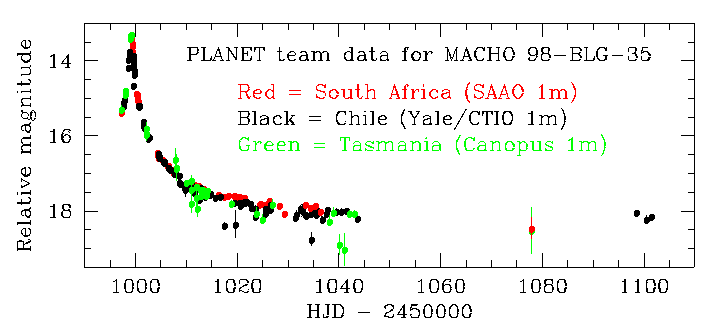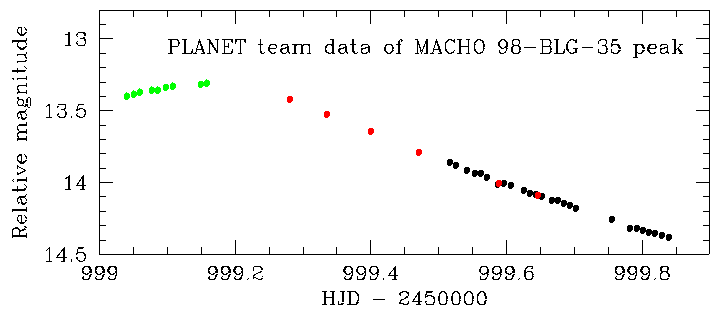
Introduction: Microlensing is a new technique capable of detecting extra-solar planets orbiting very distant stars in the Galaxy. Recently, the microlensing technique has received media attention when a press release was issued claiming the possible detection of a planet with a mass between that of Earth and Neptune orbiting a very distant low-mass Galactic star. This announcement was made by a team of astronomers, known as the MPS and MOA collaborations, based on their microlensing observations of an event known as MACHO 98-BLG-35, originally discovered by the MACHO team. Because the MPS/MOA group has reported that the claimed planet orbits this low-mass star at radii somewhat larger than the Earth orbits the Sun, some have even speculated that if it exists, it may harbor life.
The PLANET collaboration: The PLANET collaboration is an international team of astronomers that for four years has been performing precise and frequent microlensing observations with telescopes around the world in order to study interesting features in microlensing light curves, including those caused by planets orbiting the lenses. Due to the media attention given this event, and the natural public interest, PLANET has decided to display publicly its own observations of this event, which were taken as part of its normal operations in 1998. PLANET analysis of its own data is on-going; results will be reported only after a thorough analysis.


Need for further analysis: In order to be certain what this light curve might tell us about the lens and whether or not it has any planets orbiting it, a careful analysis of these data must now be done. This is especially important because the kind of anomalies (wiggles) in the light curve that can be caused by planets will usually be small in size and last for only a short period of time. This means that often more than one scientific interpretation can be attached to the same real anomaly and also that observational difficulties can sometimes masquerade as real anomalies. When the PLANET team has finished considering these possibilities, it will present its conclusions on this event based on its own data. Read on to understand why it is important that we do this analysis.
Measurement uncertainties: The vertical lines (error bars) attached to every point represent estimates of the measurement uncertainty for that point made by the computer program that analyzed the images. As the object gets fainter, the brightness is more difficult to measure and the error bars get larger. Usually, discrepant points that seem to lie above or below the general trend have the largest error bars. Because the observations are so difficult, however, the program sometimes underestimates the uncertainty, and attaches an error bar that is too small. The reliability of the error bars must be understood before we can know whether points that lie above or below the trend are real microlensing effects, or just uncertain measurements.
 Difficult observations:
Microlensing events are rare (any given star has little more than a
one-in-a-million chance of being lensed)
and events are found only where there are
millions of stars. Most microlensing events have been found by
looking in directions close to the center of our Galaxy,
were the stellar fields are very crowded (see right).
In poor observing conditions light from neighboring stars (or even
the moon!) can be confused with that from the background lensed star.
Care must be taken in the analysis to ensure that moonlight and
atmospheric distortions from turbulent atmosphere above the telescope
do not cause wiggles in the microlensing light curve that could
be misinterpreted as a planet.
Difficult observations:
Microlensing events are rare (any given star has little more than a
one-in-a-million chance of being lensed)
and events are found only where there are
millions of stars. Most microlensing events have been found by
looking in directions close to the center of our Galaxy,
were the stellar fields are very crowded (see right).
In poor observing conditions light from neighboring stars (or even
the moon!) can be confused with that from the background lensed star.
Care must be taken in the analysis to ensure that moonlight and
atmospheric distortions from turbulent atmosphere above the telescope
do not cause wiggles in the microlensing light curve that could
be misinterpreted as a planet.
Systematic effects: Another part of the analysis that must be done is to study ``systematic effects.'' These are conditions in the experiment that can cause some data points to always be higher or lower than expections. Effects from atmospheric turbulence and moonlight are examples. Data from different telescopes can also exhibit systematic differences. Notice for example, that the red South African data seem to be aligned with the black Chilean data near the peak of the light curve, but misaligned near day number 1035. If these sorts of systematic effects go unnoticed, deviations in the data caused by them might be attributed to the wrong cause. The PLANET team continues to develop techniques to remove some of these troublesome effects. To see our conclusions about planets in a different lensing system and the importance of removing systematic effects, read our paper on OGLE-1998-BUL-14.
The data presented here are preliminary and subject to further analysis. We kindly request that any use of this information or reproduction of these figures in the press or any other reports acknowledge the PLANET collaboration and this http address.